This day featured the main event at Mulino, a large-scale iteration of maneuver defense by a coalition grouping of forces, luring the opposing force into prepared fire cauldrons, degrading them, counterattacking with massed fires and strike systems through the depth of their lines, and then conducting a counteroffensive. The exercise featured the 31st Air Assault Brigade, extensive air support and bombing from VKS Aerospace Forces, attack helicopters, drone strikes, large concentrations of supporting artillery (SPA and MLRS), extensive minewarfare, and use of combat engineer-sapper units. At other ranges there were notable paradrops, including a night drop by the VDV’s 45th Guards Spetsnaz Brigade. Three Iskander-M launches took place at different ranges, SRBM and cruise missiles fired. Meanwhile the Northern Fleet continued its battle against an unidentified force of marines which had made an amphibious landing on Kola Peninsula.
Special thanks to Konrad Muzyka for helping put together a number of the events and activities here, and as a second set of eyes in case I miss something.
Near Ryazan
The 106th VDV Division which had a battalion packed and ready to drop for a few days now finally deployed. Best guess it was 137th Airborne Regiment. The opposing force was deploying reserves into the fight, and coalition command decided to call upon operational-tactical airborne. This seems to be the current designation for parachute regiments. They dropped at two different sites near Zhitovo with 300 paratroopers and 30 BMD-4M infantry fighting vehicles, aboard 21 x Il-76MD transport aircraft (together with 20 Indian paratroopers). Paradrop took place at about 800-1100 meters, with air cover provided by Su-35S.
Strugi Krasnye
A battalion from the 104th Air Assault Regiment of the 76th Airborne Division conducted maneuver defense operations at the training ground. An OPFOR of 1500 attacked Russian positions, which were being defended by an airborne BTG. They were initially met by a BMD-4M equipped air assault platoon. The subunit moved back to prepared lines, luring OPFOR into an ambush. The OPFOR stood no chance against BMD-4Ms and the 2S25 Sprut self-propelled tank destroyer/light tank. An air defense component of the exercise included 9K333 Verba engaging aerial targets.
At Mulino, Nizhny Novgorod Oblast – Main Event
The overall scheme for events at Mulino involves a coalition grouping of forces holding a defensive line against an enemy offensive which had pushed 80km into coalition territory, and then mounting a large counteroffensive. This was another case of maneuver defense, and a ‘perforating’ attack with fires against the enemy forces at a tactical-operational level. In the first phase of the event, they goal was to pull the OPFOR’s initial echelons into an operational envelopment, and deflect their air attack. Then deploy airborne units and commit mobile reserves. In the second phase, the Northern Coalition attempted to disrupt the opponent’s system of command and control (disorganize), attain superiority in fires, and reduce their combat potential via a concentrated strike across the entire operational depth of their forces – using recon-fire and recon-strike complexes (its contours or loops, not complexes, whoever wrote this is using older terms). In phase three, the Russian-led coalition’s goal was to crush OPFOR, deploying tactical and tactical-operational airborne units, bypassing parts of their force, and seizing populated sectors. The exercise also tested elements of combat service support and logistical elements, resupplying the force with ammunition, maintenance, etc.
Putin was there, looking at the event through a pair of binoculars while Gerasimov explained things. In Zapad-2017 he was there on the 5th day, like during most strategic command-staff exercises, but this time they had the main event earlier. Notably they keep him sequestered due to covid, forcing everyone to quarantine well in advance, so spotting him in a command center filled with people is actually a rare sight these days.
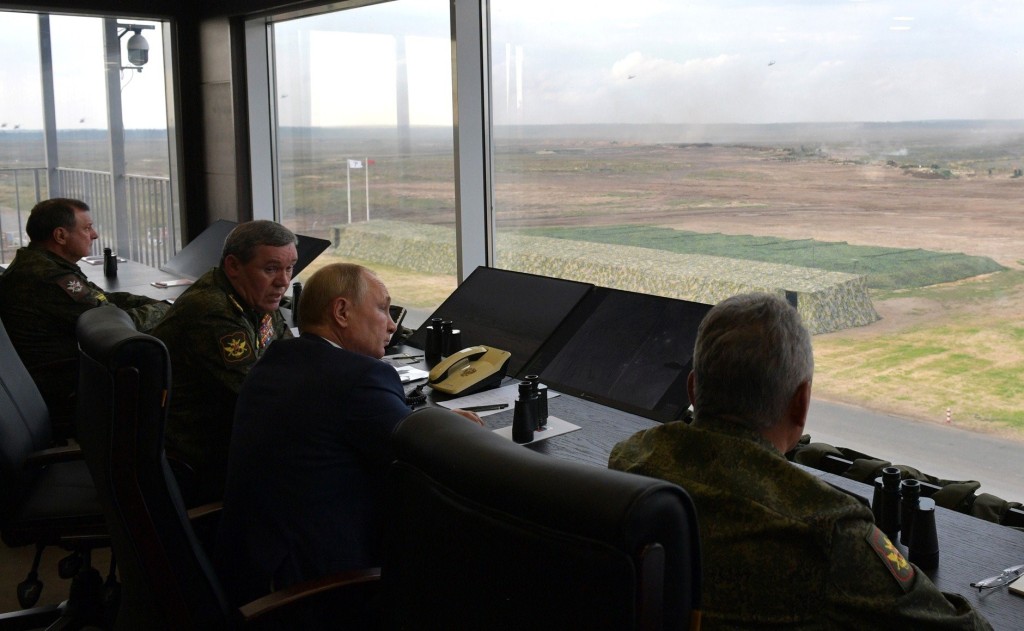
Belarusian T-72B tank units (a reinforced armored company) practiced maneuver defense, together with Russian motor rifle detachments, forcing the opposing force to suffer attrition and attack with their main body of forces in an unfavorable direction. This tactical scenario has been repeated several times in Zapad now, armored forces retreating from forward defense positions under the cover of smokescreens to avoid being decisively engaged, only to take up a new defensive line. This tactic is called ‘rolling.’ Their goal is to lure the opponent into a fire cauldron (or pocket), which is also heavily mined. The fire pocket is a prepared sector, where artillery and other units can decimate an opposing force from multiple directions with direct and indirect fires, while minelayers block mobility. This exercise featured mining to block the opponent’s advance using GMZ-3 minelayers, and heliborne mining via Mi-8MT. There’s mention of a different type of formation employed, mobile tactical groups, which sounded just like BTGs, except these were reinforced by BMPT Terminator units. These were supported by mine clearing vehicles and TOS-1A MLRS.
Airborne
The 31st Air Assault Brigade together with a Belarusian tank battalion tactical group (19th Mechanized Brigade), as part of a joint operation. The airborne operation is referenced as 31st deploying a “mobile strike echelon.” Objective: prevent breakthrough by opposing coalition forces, fill the gaps or reinforce key areas that might be overrun. This time they deployed 12 Mi-8AMTSh transport helicopters (although in total airborne operations at Mulino involved 32 Mi-8 variants), with cover from 14 Mi-24, Mi-28N, Ka-52 attack helicopters. They brought in Sarmat-2 ground mobility vehicles so that forces could rapidly seize key positions, and as has become commonplace D-30 122mm howitzers for artillery support. Helicopters airlifted Sarmat-2 light ground mobility vehicles, whose attack helped disrupt opposing forces. These light units were working in conjunction with an air assault battalion mounted on BMD-4Ms, and a Belarusian tank BTG fielding T-72B1s.
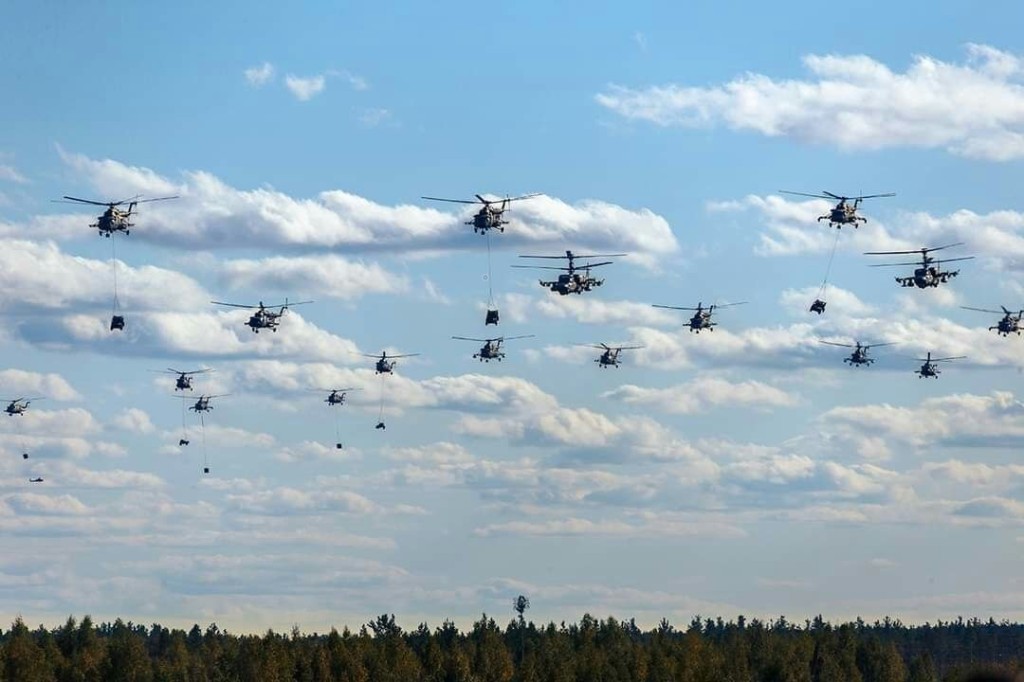

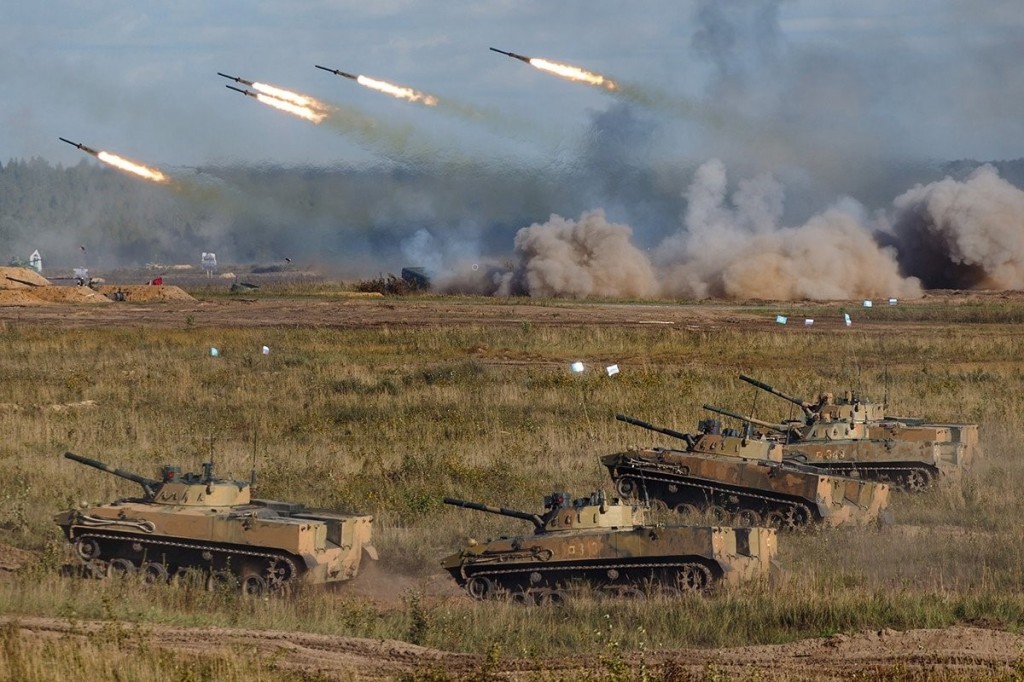
Russian (31st) and Kazakhstani (35th Air Assault Brigade) forces had a separate training exercise in an urban environment. After attacking the enemy with 4x Sarmat vehicles and attack helicopters, they assaulted buildings, engaging in urban combat. Assault-engineer units created entrances through walls, demined buildings, and prepared it to be demolished. A battery of D-30 towed 122mm howitzers, brought in by the Mi-8s, provided support for this event. Also they had 82mm mortars, and two units with Kornet ATGMs. This event was a planned battle in the city, featuring about 300 paratroopers from Russia and Kazakhstan, with 10 helicopters supporting.
Air Support
Russian Aerospace Forces executed a massed aviation strike against enemy forces at Mulino, involving more than 60 aircraft. Su-24MR reconnaissance, 12x Su-25SM3 attack, 16x Su-30SM heavy-multirole, 6x Su-35S air superiority, 16x Su-34 and 6x Su-24 tactical bombers, along with 6x Tu-22M3 bombers. Essentially tactical-operational, and long-range aviation. Su-24MR conducted strikes and reconnaissance of enemy targets, then Su-35S engaged in air-to-air combat against enemy fighters. Enemy air defense, deployed in starting positions, was destroyed with 48 high-explosive fragmentation bombs delivered by Su-25SM3. Judging from exercise depiction they were unguided, but using SOLT-25 navigation system with thermal imaging. Four flights of Su-34s were also in support, destroying important targets further behind enemy lines with 24x 500kg bombs. Bombing done at 600-1200 meters. 6x Tu-22M3 from 22nd Hvy Bomber Division flew sorties, dropping 1500kg bombs in pairs on enemy command centers from an altitude of 1000-2000m (that’s a 3300lb bomb to us colonials). They based out of operational airfields in Saratov and Kaluga regions.
Several types of drones were used, including Orion, Forport, Orlan-10, and Lastochka. Not sure if the story is right, claims they used 120mm laser guided mortar munitions called Gran, but from Lastochka which is a very small UAV. Videos show use of KAB-20S small guided bomb from Forpost-R. They also employed Orlan-10 with unguided munitions called ‘Mirotvorets.’
Artillery fires and strike systems
According to the MoD release, 12 battalions of MSTA-S participated at Mulino, more than 140 self-propelled systems in the 152mm caliber. Number seemed a bit off, maybe organizationally 12 battalions were involved, but 12 battalions would total 216 SPA not 140. A specialized recon-fire complex, by the name of Zemledelie, was employed against enemy reserve forces. Zemledelie is a 122mm (ISDM) engineering distance mining system – essentially a multiple launch rocket propelled mining system – able to put down a minefield of 600×200 meters at a range of 15km. This vehicle has been making appearances in greater numbers, they had quite a few more at Zapad than in Kavkaz-2020. About 10x TOS-1A Solntsepek 220mm thermobaric MLRS systems were involved in the exercise as well. They were used in conjunction with Zemledelie against enemy columns and reserve units. Interesting combination of distance mining and thermobaric MLRS.
An Iskander-M battalion (4 TELs – maybe 448th?) deployed 50km from Mulino executed a grouped missile strike against enemy command points and other critically important targets. They used both the 9M723 SRBM and 9M728 cruise missile. So, this is a different unit than at Luzhsky, for what may be a total of 3 Iskander launches on this day.
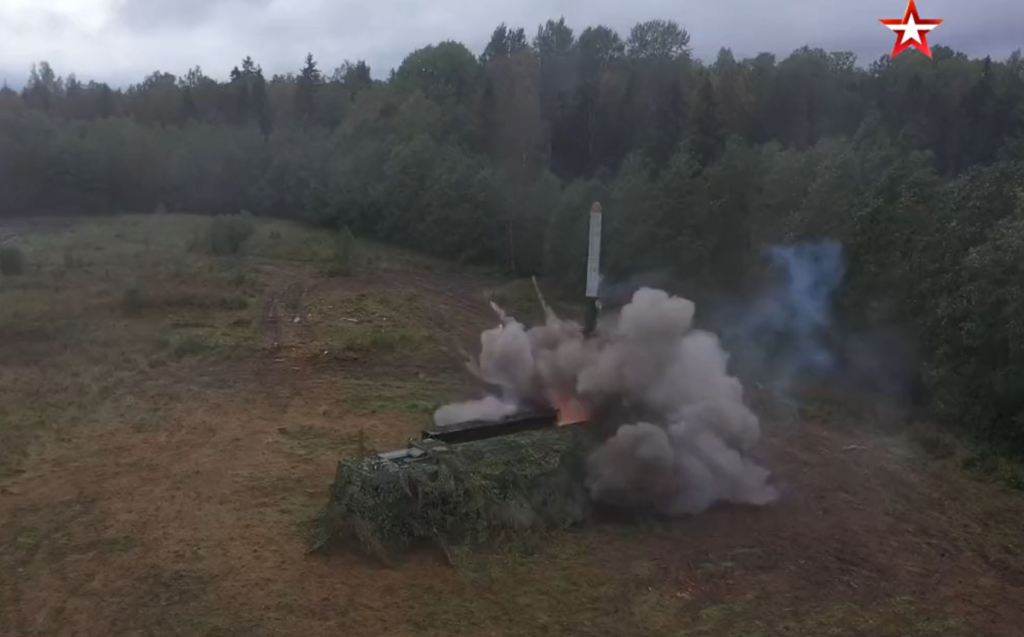
The Iskander-M launch near Mulino was a 2x SRBM launch, video surfaced later.

They rolled out Uran-9 and Nerekhta UGVs. Uran-9 features 4xAtaka ATGMs, 12x RPO PDM-A thermobaric grenade launchers, a 30mm autocannon, and PKTM machine gun. Basically, its armed to the teeth. It had test reports from Syria which suggested the vehicle had a long way to go in development to meet requirements for reliable distance operation, fidelity in sensors, and other issues. So, it’s got a ton of weapons, but functionality is a different issue. As far as big UGVs go, it is probably the ED-209 of the bunch. Nerekhta is quite small and can have different combat modules, but standard loadout is 12.7mm machine gun and 30mm AG-30M grenade launcher. Also, they displayed 3-4 B-19 vehicles, a BMP-3 platform with Epocha combat module (57mm autocannon, Kornet ATGMs, and smaller caliber ATGMs Bulat). B-19 BMP variant looked neat, except that there was clearly scoring and burn marks on the side of the turret from its own Kornet ATGM fire, looks like it needs minor tweaks.
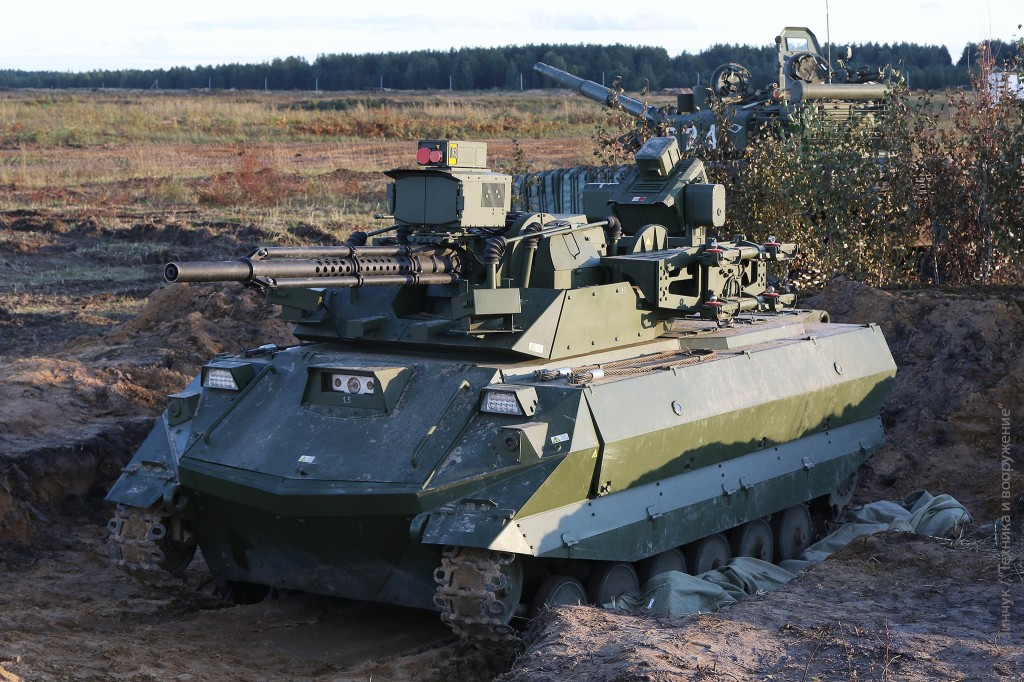

Combat engineers setup a dummy tank battalion in defense, along with dummy Buk and S-300 units. This allowed them to lure enemy forces into attacking the wrong sector, and similarly mislead an enemy air attack against a dummy air defense battalion.
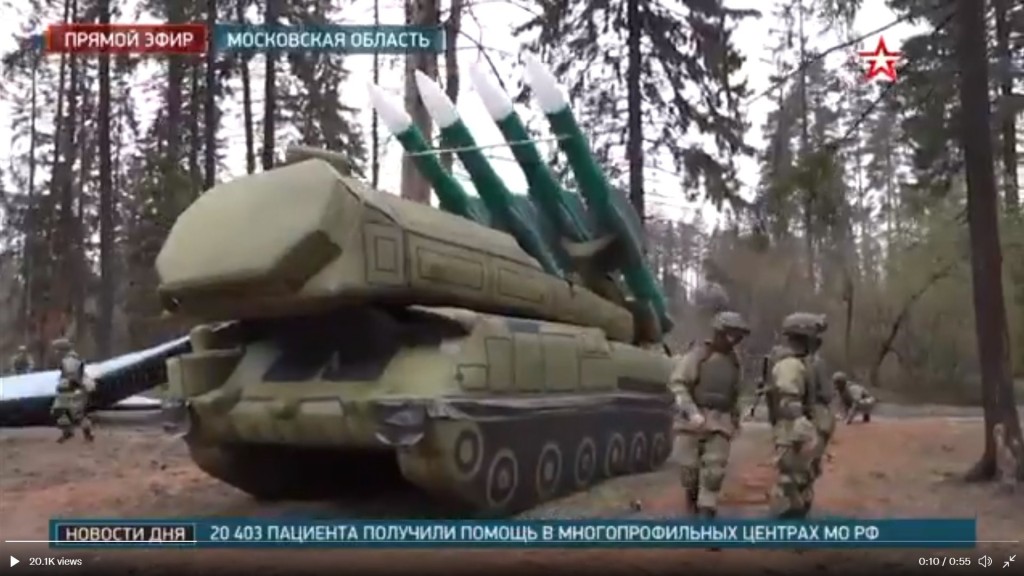
They also setup another fire wall using trenches filled with flammables – multiple rows at a 1.5km length. A different article said 1km length, but who’s counting. This time engineers activated the fire wall across three different lines using highly flammable liquid. There was also a VIED exercise, simulating the kind of up armored technicals and suicide bombers encountered in Syria.
At Luzhsky training ground
Several Su-24MR reconnaissance aircraft scouted the area for ground targets, then transmitted the data and coordinates to a follow up flight of 4 x Su-34s via a closed communication channel.
An Iskander-M launch of 9M728 cruise missile took place at the range, most likely by the 26th Missile Brigade. It was used to strike targets at ranges of 100km, just as the crew had practiced via simulated electronic launches a few days beforehand.
Ashuluk
The Russian MoD confirmed that a unified air defense system had been created in support of Zapad. It includes all forces, units, and assets tasked with early warning, and repelling air attack. These assets are controlled from one C2 center. The use of an automated control system makes it possible to identify and distribute air targets. Engagement should also be automatic. Air defense units drilling at Ashuluk operate within a highly contested electronic warfare environment in conditions of radio suppression and radio jamming in various frequency ranges. Interestingly, one of the Pantsir units showed by the Russian MoD came from the Kirov Oblast, which is not known to field any SAM regiments. It is plausible that the system was withdrawn from storage and put into operational use? Perhaps this is a mobile reserve air defense unit?
At Brest, Belarus
45th Guards Spetsnaz Brigade (VDV), together with airborne units from Belarus and Kazakhstan, conducted a night time paradrop at the training range from 3 x Il-76MD at altitudes of 1500-1900m. About 90 reconnaissance paratroopers from the 45th, 60 from Belarus, and 20 from Kazakhstan. Russians used Arbalet-2 parachute system flying out of Kubinka, Belarusians used D-4 parachutes coming out of Machulishi. After landing, paratroopers practiced diversionary actions behind enemy lines, raiding, reconnaissance, and destroying objects in the enemy rear.

Baltic Fleet
Saboteurs seized areas where the Baltic Sea Fleet ships were moored. Elements of the 61st Naval Infantry Brigade (Northern Fleet) and the 313th PDSS were sent in to recapture the area and neutralize the threat. They were deployed onshore through fast boats. The diversionary forces were blocked at the pier and “destroyed”. Altogether 50 personnel, 10 pieces of equipment, a Ka-29 and Ka-27 helicopter involved. The abovementioned detachment worked to prevent the breakthrough of underwater saboteurs to ships that were being loaded with weapons at the naval base.
Northern Fleet
14th Army Corps continued a second day of exercises on the Kola Peninsula, together with airborne units which had been deployed to reinforce them. They continued defending the coast against an enemy marine force which had been landed via amphibious operation. The focus this day was on the Sredniy peninsula, with 100 pieces of equipment and 800 troops. T-80BVMs completed a 100km march together with motor rifle units mounted on MT-LBs, and then practiced firing at different types of targets, backed by 2S1 Gvozdika SPA, and man portable Kornet ATGMs. Exercise involved employing camouflage, providing combat engineer support, and elements of air defense.
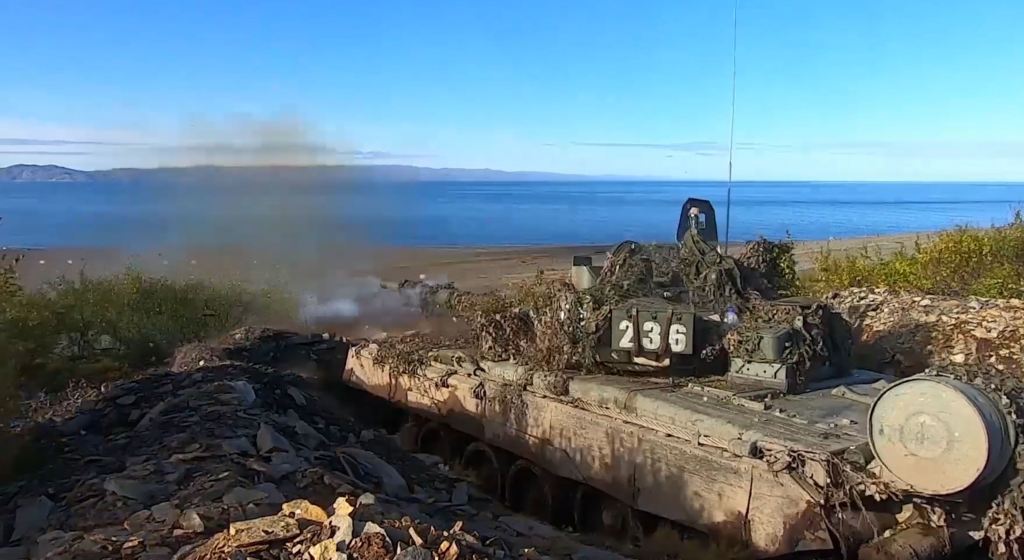
Meanwhile back at the Arctic expeditionary group which had sailed up the Yenisei river, PDSS units continued to train in countering diversionary operations and providing security for the small naval group that been sent there. Exercises took place along the river and at the port of Dudinka. They included Udaloy-class Severomorsk, which had been docked there for several days, along with Rapucha-class LST Georgiy Pobedonosets, and tugboat Pamir.
Some additional photos
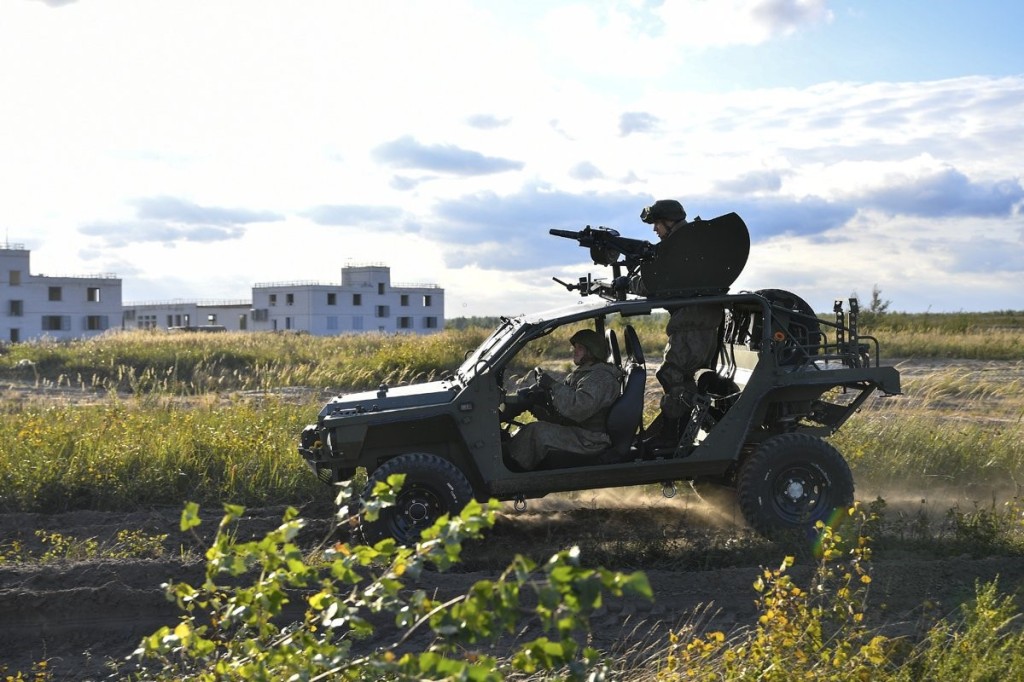





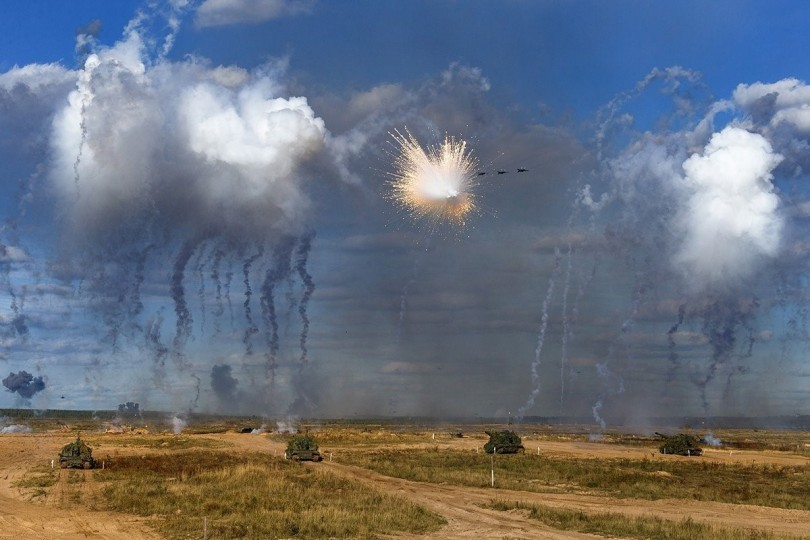
Rehellisiä ollaksemme: Miksi Venäjä pelkää länttä ja NATOA? Sukupolvesta toiseen. Länsimaat eivät ole koskaan hyökänneet Venäjää vastaan. Toisin päin on hyökätty. Aihetta olisi pelätä ja varustaa Kiinaa vastaan, lännen avuksi.
LikeLike